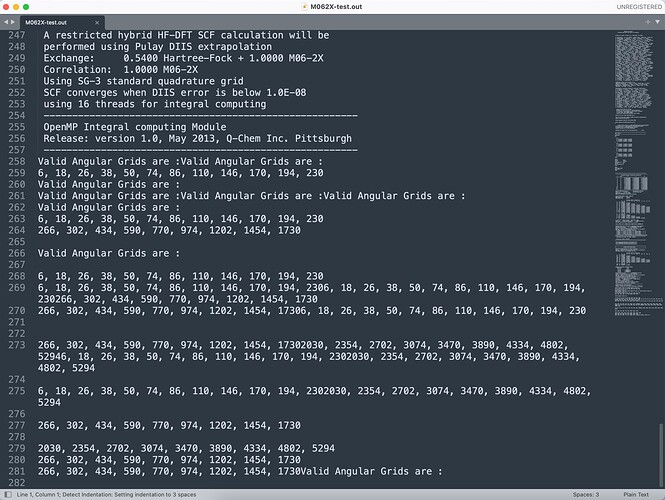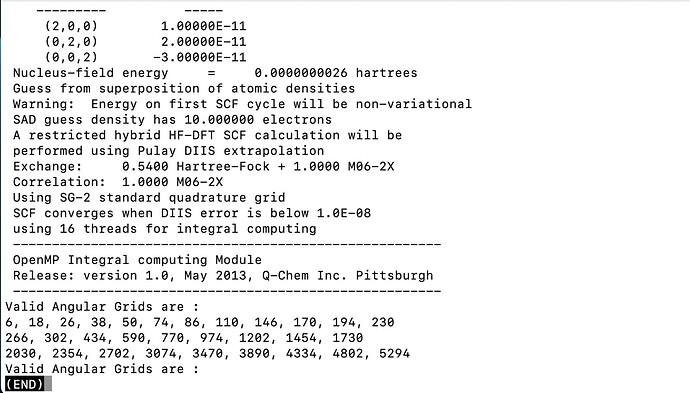I tried to use EE-MBE(5) with MBCP(3) together. However there is a fatal error shown in the output file.
Below is an example input file.
$molecule
0 1
0 1
O 0.869814 -0.308378 1.89967
H -0.008612 -0.688794 1.738084
H 1.460453 -0.71418 1.245674
0 1
O -1.538103 1.24802 -0.689795
H -2.064517 2.006738 -0.957852
H -0.63932 1.585287 -0.39437
0 1
O 0.847644 1.825352 0.158655
H 0.85595 1.309476 0.991971
H 1.484921 1.336578 -0.387661
0 1
O -1.76055 -0.950397 0.92856
H -1.944978 -0.083888 0.512023
H -2.532079 -1.205578 1.442529
0 1
O -0.385224 -1.194789 -1.544733
H -0.844826 -1.599945 -0.793796
H -0.833734 -0.337689 -1.640882
0 1
O 2.089047 -0.584294 -0.688915
H 2.82847 -0.993202 -1.147856
H 1.257252 -0.898923 -1.115408
$end
$rem
SYM_IGNORE true
METHOD B3LYP
BASIS cc-pVDZ
MANY_BODY_INT true
THRESH 14
SCF_CONVERGENCE 8
$end
$mbe
order 5
embed charges
bsse_type mbcp
bsse_order 3
$end
$mbe_charges
-0.333921
0.152824
0.156186
-0.363297
0.164759
0.197198
-0.329979
0.171374
0.164944
-0.316142
0.167193
0.167787
-0.322626
0.166267
0.164000
-0.338994
0.160648
0.171782
$end
And the error message in the output file.
Does anyone know how to fix this?
Thanks.
I can reproduce this error with the latest version (v. 6.1) of Q-Chem but it’s not clear to me what the problem is. Please contact Q-Chem support. Note that if you switch the SCF method to HF/STO-3G, the job runs (and fails) very quickly so that’s a way to try some variations. I got it to run with the following combinations:
(order, bsse_order) = (3,2), (3,3)
it may be the case that for MBE(n) and MBCP(n), the n can’t be larger for one than the other. Please test this out and perhaps contact Q-Chem support. If that’s indeed the limitation then I can at least add a note to the manual.
I got one more question here.
I already tried with (order, bsse_order) = (3,3), it works fine with pure water clusters. However, when I added an ion, like Li and Na, the MBCP(3) seems to be extremely large in these cases. Is it also a potential limitation for the MBCP?
Example input:
$molecule
1 1
1 1
Na 0.4027223553 -2.8254108252 6.027262371
0 1
O 0.2455350032 -1.5645397723 3.9951573953
H 0.0091076424 -0.6352611893 3.8633421436
H -0.6003878475 -2.0690324536 3.9941078834
0 1
O 1.2315523851 -4.6894065458 4.8160102479
H 1.7911086392 -4.3251301625 4.1026186918
H 1.8424790583 -5.0502195097 5.493578112
0 1
O -1.1680805346 -5.7639904778 5.3165005669
H -0.3099641717 -5.6359734833 4.8566791465
H -1.54202886 -6.6086794783 5.0293621176
0 1
O -1.7126384095 -3.1134067236 4.9545852844
H -1.8058369128 -4.0893839088 4.9742386514
H -2.0905709789 -2.7748398682 5.7862868649
0 1
O -0.088642541 -4.5316859555 7.5503245261
H 0.7953622989 -4.9003996804 7.7384262919
H -0.5457935273 -5.1861217211 6.9829825422
0 1
O 2.6264260223 -2.7424805948 3.504059232
H 1.7990160379 -2.2270897388 3.3754767119
H 3.1979158565 -2.5871769561 2.7388336145
0 1
O 2.7139587505 -2.4551080126 6.2082507426
H 2.9283296948 -2.4749275436 5.2456402429
H 3.118723869 -1.6518239056 6.5664112571
0 1
O -1.2620821598 -2.1295659095 7.5267706758
H -1.0709659837 -2.9498951512 8.0219621401
H -1.5658741494 -1.4695885836 8.164438038
0 1
O 2.625613079 -5.0273667598 7.1448476662
H 2.9498359827 -4.1092099463 7.040004503
H 3.3511774014 -5.557286143 7.5038423392
$end
$rem
SYM_IGNORE true
METHOD B3LYP
BASIS cc-pVDZ
MANY_BODY_INT true
THRESH 14
SCF_CONVERGENCE 8
$end
$mbe
order 3
embed charges
bsse_type mbcp
bsse_order 3
$end
$mbe_charges
1.00000
-0.89423
0.44711
0.44711
-0.89423
0.44711
0.44711
-0.89423
0.44711
0.44711
-0.89423
0.44711
0.44711
-0.89423
0.44711
0.44711
-0.89423
0.44711
0.44711
-0.89423
0.44711
0.44711
-0.89423
0.44711
0.44711
-0.89423
0.44711
0.44711
$end
Do you have any idea about this?
Thanks in advance.
It’s possible this is a real effect, since BSSE is essentially charge transfer and one might expect that to be much larger in a water-cation system than it is in pure water. I suggest you try some small example by hand where you can run the various n-body calculations yourself. MBCP(n) is quite straightforward (whereas VMFC(n) is less so for n > 2). See:
https://doi.org/10.1021/jz401368u
It is a real limitation that MBE(n) should not larger than MBCP(n).
Actually it doesn’t make sense to take MBCP(n) to higher order than MBE(n), and furthermore most of the BSSE comes from one- and two-body terms, since BSSE is essentially a charge-transfer effect and that probability falls off with orbital overlap, or in other words exponentially with distance.
That said, if you’d like to contribute MBCP(n) for n > 3, please consider becoming a Q-Chem developer.
Also, I’ve noticed that MBCP doesn’t work with some functionals (like M06-2X), is there a particular reason for this?
please provide an example in the form of an input file
Here is the input file:
$molecule
0 1
0 1
O -1.126149 -1.748387 -0.423240
H -0.234788 -1.493897 -0.661862
H -1.062789 -2.681331 -0.218819
0 1
O -0.254210 1.611495 -1.293845
H -1.001520 1.163510 -1.690129
H -0.153399 2.411746 -1.809248
0 1
O 1.694541 -0.226287 1.705739
H 0.785920 0.073487 1.677909
H 2.047134 0.150917 2.511706
0 1
O -0.864533 0.522472 1.218817
H -0.694120 1.093542 0.469789
H -1.131418 -0.310426 0.829702
$end
$rem
method m062x
basis cc-pvdz
many_body_int true
thresh 14
scf_convergence 8
$end
$mbe
bsse_type mbcp
bsse_order 3
$end
And below is the end of the output file:
what happens if you specify XC_GRID = 2 in $rem ? (That should be the default for M06-2X)
This appears to be related to XC_GRID = 2, which is the default for M06-2X. I can get the job to run either with XC_GRID = 1, which is not recommended for this functional, or else XC_GRID = 000099000590, meaning a (99,590) grid, which should be okay quality-wise albeit slower than SG-2.
I have posted a bug ticket to try to get this fixed, but what I said above is the workaround.




